Students can Download Economics Chapter 4 Cost and Revenue Analysis Questions and Answers, Notes Pdf, Samacheer Kalvi 11th Economics Book Solutions Guide Pdf helps you to revise the complete Tamilnadu State Board New Syllabus and score more marks in your examinations.
Tamilnadu Samacheer Kalvi 11th Economics Solutions Chapter 4 Cost and Revenue Analysis
Samacheer Kalvi 11th Economics Cost and Revenue Analysis Text Book Back Questions and Answers
Part – A
Multiple Choice Questions
Question 1.
Cost refers to _______
(a) price
(b) value
(c) fixed cost
(d) cost of production
Answer:
(d) cost of production
Question 2.
Cost functions are also known as …………………….. function.
(a) Production
(b) Investment
(c) Demand
(d) Consumption
Answer:
(a) Production
![]()
Question 3.
Money cost is also known as _______ cost.
(a) explicit
(b) implicit
(c) social
(d) real
Answer:
(a) explicit
Question 4.
Explicit cost plus implicit cost denote ………………… cost.
(a) Social
(b) Economic
(c) Money
(d) Fixed
Answer:
(b) Economic
Question 5.
Explicit costs are termed as
(a) out of pocket expenses
(b) social cost
(c) real cost
(d) sunk cost
Answer:
(a) out of pocket expenses
Question 6.
The costs of self – owned resources are termed as ……………………… cost.
(a) Real
(b) Explicit
(c) Money
(d) Implicit
Answer:
(d) Implicit
![]()
Question 7.
The cost that remains constant at all levels of output is _______ cost.
(a) fixed
(b) variable
(c) real
(d) social
Answer:
(a) fixed
Question 8.
Identify the formula for estimating average variable cost.
(a) TC/Q
(b) TVC/Q
(c) TFC/Q
(d) TAC/Q
Answer:
(b) TVC/Q
Question 9.
The cost incurred by producing one more unit of output is _______ cost.
(a) variable
(b) fixed
(c) marginal
(d) total
Answer:
(c) marginal
Question 10.
The cost that varies with the level of output is termed as …………………. cost.
(a) Money
(b) Variable cost
(c) Total cost
(d) Fixed cost
Answer:
(b) Variable cost
Question 11.
Wage is an example for _______ cost of the production.
(a) fixed
(b) variable
(c) marginal
(d) opportunity
Answer:
(b) variable
![]()
Question 12.
The cost per unit of output is denoted by …………………… cost.
(a) Average
(b) Marginal
(c) Variable
(d) Total
Answer:
(a) Average
Question 13.
Identify the formula of estimating average cost.
(a) AVC/Q
(b) TC/Q
(c) TVC/Q
(d) AFC/Q
Answer:
(b) TC/Q
Question 14.
Final total cost where TFC = 100 and TVC = 125.
(a) 125
(b) 175
(c) 225
(d) 325
Answer:
(c) 225
Question 15.
Long-run average cost curve is also called as _______ curve.
(a) demand
(b) planning
(c) production
(d) sales
Answer:
(b) planning
Question 16.
Revenue received from the sale of products is known as …………………….. revenue.
(a) Profit
(b) Total revenue
(c) Average
(d) Marginal
Answer:
(b) Total revenue
Question 17.
Revenue received from the sale of an additional unit is termed as _______ revenue.
(a) profit
(b) average
(c) marginal
(d) total
Answer:
(c) marginal
Question 18.
Marginal revenue is the addition made to the ……………………….
(a) Total sales
(b) Total revenue
(c) Total production
(d) Total cost
Answer:
(b) Total revenue
Question 19.
When price remains constant, AR will be _______ MR.
(a) equal to
(b) greater than
(c) less than
(d) not related to
Answer:
(a) equal to
![]()
Question 20.
A bookseller sold 40 books with a price of ₹10 each. The total revenue of the sellers is ₹ …………………….
(a) 100
(b) 200
(c) 300
(d) 400
Answer:
(d) 400
Part – B
Answer the following questions in one or two sentences
Question 21.
Define cost.
Answer:
Cost refers to the total expenses incurred in the production of a commodity. Cost analysis refers to the study of behaviour of cost in relation to one or more production criteria, namely size of output, the scale of production, prices of factors, and other economic variables.
Question 22.
Define cost function?
Answer:
The functional relationship between cost and output is expressed as ‘Cost Function’.
A Cost Function may be written as
C = f (Q)
Eg: TC = Q3 – 18Q2 + 91Q + 12
Where, C = Cost, and Q = quantity of output. Cost functions are derived functions because they are derived from Production Functions.
Question 23.
What do you mean by fixed cost?
Answer:
- Fixed Cost does not change with the change in the quality of output.
- Fixed Cost is also called as “Supplementary Cost “or Overhead Cost”.
- All payments for the fixed factors of production are known as Total Fixed Cost.
Question 24.
Define Revenue?
Answer:
The amount of money that a producer receives in exchange for the sale of goods is known as revenue. In short, revenue means sales revenue. It is the amount received by a firm from the sale of a given quantity of a commodity at the prevailing price in the market.
Question 25.
Explicit Cost – Define.
Answer:
Payment made to others for the purchase of factors of production is known as Explicit Costs. It refers to the actual expenditures of the firm to purchase or hire the inputs the firm needs.
Question 26.
Give the definition for ‘Real Cost’?
Answer:
Real Cost refers to the payment made to compensate for the efforts and sacrifices of all factor owners for their services in production. Real Cost includes the efforts and sacrifices of landlords in the use of land, capitalists to save and invest, and workers in foregoing leisure. Real costs are considered pains and sacrifices of labour as the real cost of production.
Question 27.
What is meant by Sunk cost?
Answer:
A cost incurred in the past and cannot be recovered in the future is called a Sunk Cost. This is historical but irrelevant for future business decisions. It is called sunk because, they are unalterable, unrecoverable and if once invested it should be treated as drowned or disappeared.
Part – C
Answer the following questions in One Paragraph
Question 28.
Distinguish between fixed cost and variable cost.
Answer:
Fixed Cost:
- Does not change with the change in the quantity of output.
- It is also called ‘Supplementary cost’ or ‘Overhead cost’.
- (Eg.) Rent of the factory, Permanent worker’s salary.
Variable Cost:
- These costs vary with the level of output
- It is also called ‘Prime cost’, ‘Special cost’ or ‘Direct cost’.
- (Eg.) Cost of raw materials, Temporary worker’s salary.
Question 29.
State the differences between money cost and real cost.
Answer:
Money Cost:
- It is the total money expenses incurred by a firm in producing a commodity.
- It includes the cost of raw materials, payments of wages and salaries, rent, interest, etc.,
- It is also called prime cost or direct cost or nominal cost.
Real Cost:
- It refers to the payment made to compensate for the efforts and sacrifices of all factor owners for their services in production.
- It includes the efforts and sacrifices of factors of production.
- Landlords’ effort is the use of land, capitalists to save and invest, and workers in foregoing leisure.
Question 30.
Distinguish between explicit cost and implicit cost.
Answer:
Explicit Cost:
- Payment made to others for the purchase of factors of production.
- It includes wages, payment for raw material, rent, interest, expenditure on transport, and advertisement.
- It is also called accounting cost or out of pocket cost or money cost.
Implicit Cost:
- Payment made to the use of resources that the firm already owns.
- Cash payment is not made for the use of the producer’s own land, building, machinery, and other factors of production.
- Implicit cost is also called imputed cost or book cost.
Question 31.
Define opportunity cost and provide an example?
Answer:
Opportunity cost is the cost of the next best alternative use. It is the value of the next best alternative foregone.
(Eg.) A farmer can cultivate both paddy and sugarcane in farmland. If he cultivates paddy, the opportunity cost of paddy output is the amount of sugarcane output given up. Opportunity cost is also called ‘Alternative cost’ or ‘Transfer cost’.
![]()
Question 32.
Stale the relationship between AC and MC.
Answer:
There is a unique relationship between the AC and MC curves.
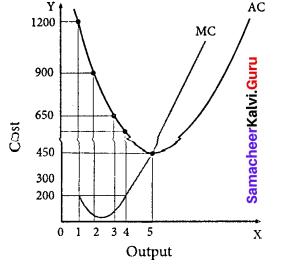
- When AC is falling, MC lies below AC.
- When AC becomes constant, MC also becomes equal to it.
- When AC starts increasing, MC lies above the AC.
- MC curve always cuts AC at its minimum point from below.
Question 33.
Write a short note on Marginal Revenue?
Answer:
Marginal revenue (MR) is the addition to the total revenue by the sale of an additional unit of a commodity
MR = \(\frac { ∆TR }{ ∆Q } \)
MR-Marginal Revenue; ∆TR – Change in total revenue, ∆Q – Change is the total quantity (OR) MR = TRn – TRn-1
TRn – Total Revenue of nth item.
TRn-1 – Total Revenue of n-1th item.
If TR = PQ, MR = dTR / dQ = P
Which is equal to AR.
Question 34.
Discuss the Long run cost curves with a suitable diagram.
Answer:
In the long run, all factors of production become variable. The existing size of the firm can be increased. There are neither fixed inputs nor fixed costs in the long run.
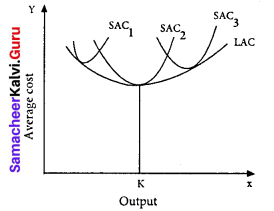
LAC = LTC/Q
LAC – Long-run average cost LTC – Long-run total cost
Q – denotes the quantity of output.
The LAC curve is derived from short-run average cost curves. It is the locus of points denoting the least cost curve of producing the corresponding output.
The LAC curve is called as ‘Planning curve’ or ‘Envelope curve’
Part – D
Answer the following questions in about a page
Question 35.
If total cost =10+Q3, find out AC, AVC, TFC, AFC when Q = 5.
Answer:
Formulas:
TC = TFC + TVC
AVC = \(\frac{TVC}{Q}\)
AFC = \(\frac{TFC}{Q}\)
AC = \(\frac{TC}{Q}\)
- TC = 10 + Q3. The total cost has two components TFC and TVC.
- TFC = is the total fixed cost that does not change with the level of output.
- It is determined by putting the value of Q.
- Given the total cost function TC = 10 + Q3
Q = units of output. Where Q = 5
Here TFC = 10 (TFC will not change when output changes)
TC = 10 + (5)3
TC = 10+125
TC = 135
∴ 135 = 10 + TVC
135 – 10 = TVC
TVC = 125
TVC = 125,
TC = 135
∴TFC = ?
TC = (TFC + TVC)
135 = x + 125
135 – 125 = 10
∴ TFC = 10
AFC = \(\frac{TFC}{Q}\)
TFC = 10, Q =5
AFC = \(\frac{10}{5}\) = 2
∴ AFC = 2
AVC = \(\frac{TVC}{Q}\)
TVC = 125,Q = 5
AVC = 125
∴ AVC = 25
AC = \(\frac{AC}{Q}\)
TC = 135,Q = 5
AC = \(\frac{135}{5}\) = 27
(or)
AC = AFC + AVC
AC = 2 + 25
AC = 27
![]()
Question 36.
Discuss the short-run cost curves with a suitable diagram.
Answer:
1. Total fixed cost: TFC
All payments for the fixed factors of production are known as total fixed costs. It does not change with output.
2. Total variable cost: TVC
All payments to the variable factors of production are called a total variable cost. As output increases, TVC also increases.
3. Total cost curves: TC
Total cost means the sum total of all payments made in the production. It is the total cost of production.
TC = TFC + TVC.
4. Average fixed cost: AFC
It refers to the fixed cost per unit of output.
AFC = \(\frac { TFC }{ Q } \)
5. Average variable cost: AVC
It refers to the total variable cost per unit of output.
AVC = \(\frac { TFC }{ Q } \)
6. Average cost:
It refers to the total cost per unit of output.
AC = \(\frac { TC }{ Q } \) (or) AC = AFC + AVC
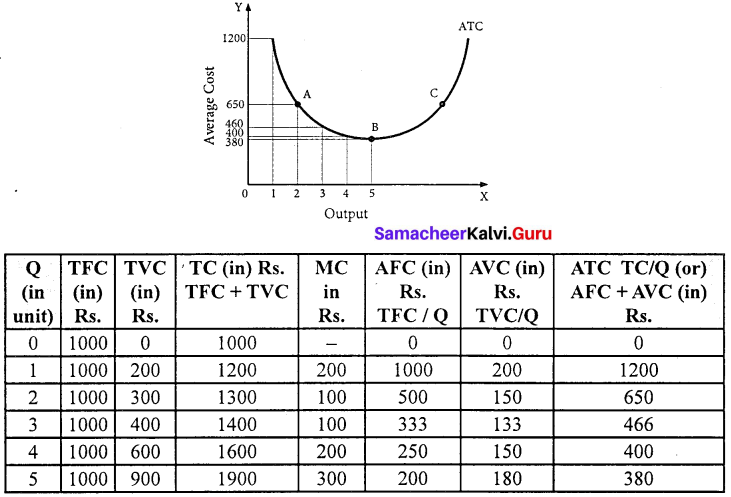
- ATC curve is also a ‘U’ shaped curve.
- Initially, ATC declines, reaches a minimum, and rises beyond the optimum output.
- The ‘U’ shape of the AC reflects the law of the variable proportions.
Marginal Cost:
Marginal cost is the addition made to the total cost by producer one extra unit of output
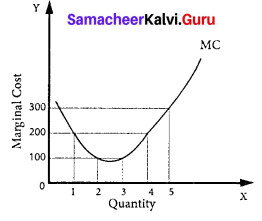
Question 37.
Bring out the relationship between AR and MR curves under various price conditions.
Answer:
If a firm is able to sell additional units at the same price then AR and MR will be constant. If the firm sells its additional units only by reducing the price then both AR and MR will fall and be different.
Constant AR and MR: (at a fixed price)
If the price remains constant, MR also remains constant and coincides with AR. Under perfect competition as the price is constant, AR is equal to MR and their shape will be straight line horizontal to X-axis.
TR – AR – MR – Constant price
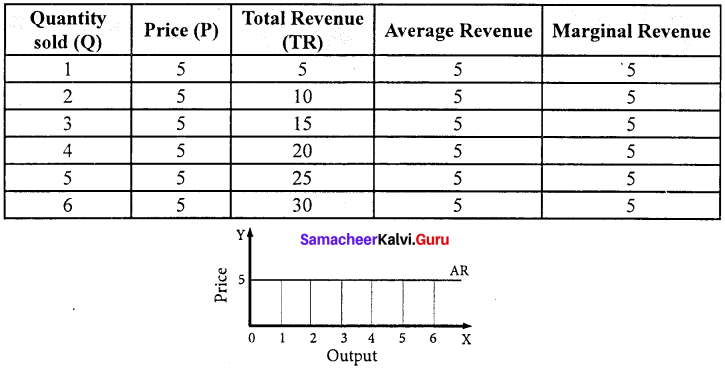
Declining AR and MR: (at declining price)
When a firm sells large quantities at lower prices both AR and MR will fall. But the fall in MR will be steeper than the fall in the AR and MR lies below AR.
The MR curve divides the distance between the AR curve and Y-axis into two equal parts. The decline in AR need not be a straight line or linear. If the prices are declining with the increase in quantity sold, the AR can be non-linear may be concave or convex to the origin
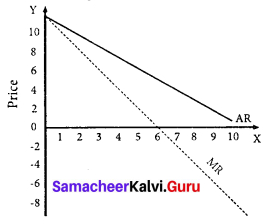
AR, TR, MR declining price
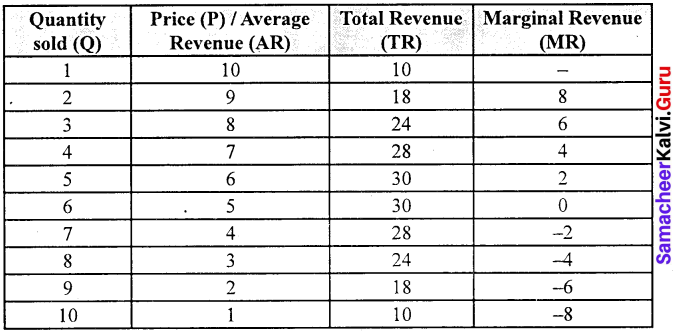
Samacheer Kalvi 11th Economics Cost and Revenue Analysis Additional Questions and Answers
Part – A
Choose the best options
Question 1.
Real Costis ……………………
(a) Pain and sacrifice
(b) Subjective concept
(c) Efforts and foregoing leisure
(d) All the above
Answer:
(d) All the above
![]()
Question 2.
Average fixed cost is obtained by _______
(a) TC / Q
(b) TFC / Q
(c) TVC / Q
(d) None of the above
Answer:
(b) TFC / Q
Question 3.
The Marginal Cost curve is ……………………..
(a) V-shaped
(b) Upward
(c) Downward
(d) U – shaped
Answer:
(d) U – shaped
Question 4.
Total fixed cost + Total variable cost is?
(a) AC-MC
(b) TC-AC
(c) TC
(d) None
Answer:
(c) TC
Question 5.
What is the break-even point?
(a) No profit no loss point
(b) No profit
(c) No loss
(d) Profit – point
Answer:
(a) No profit no loss point
Question 6.
Break-Even point is _______
(a) Total cost and total revenue
(b) Average revenue and financial revenue
(c) No profit – no loss point
(d) All the above
Answer:
(c) No profit – no loss point
Question 7.
What is the other name for “Opportunity Cost”?
(a) Real Cost
(b) Money Cost
(c) Economic Cost
(d) Social Cost
Answer:
(a) Real Cost
![]()
Question 8.
Average variable cost is _______
(a) TFC / Q
(b) TVC / Q
(c) TC / Q
(d) None
Answer:
(b) TVC / Q
Question 9.
…………………….. revenue means the price of the product.
(a) Total
(b) Marginal
(c) Profit
(d) Average
Answer:
(d) Average
Question 10.
The cost function is the
(a) Relationship between total cost and output
(b) Relationship between revenue and cost
(c) Relationship between wages and interest d. None of the above
(d) None of the above
Answer:
(a) Relationship between total cost and output
Question 11.
Match the following

(a) 1 – (iv), 2 – (i), 3 – (iii), 4 – (ii)
(b) 1 – (iv), 2 – (i), 3 – (ii), 4 – (iii)
(c) 1 – (ii), 2 – (iii), 3 – (iv), 4 – (i)
(d) 1 – (iii), 2 – (iv), 3 – (i), 4 – (ii)
Answer:
(b) 1 – (iv), 2 – (i), 3 – (ii), 4 – (iii)
Match the following and choose the answer using the codes given below
Question 1.

(a) 1 2 3 4
(b) 3 4 1 2
(c) 2 3 4 1
(d) 4 3 1 2
Answer:
(b) 3 4 1 2
Question 2.

(a) 3 4 2 1
(b) 1 2 3 4
(c) 2 3 4 1
(d) 4 3 1 2
Answer:
(a) 3 4 2 1
Question 3.

(a) 2 3 4 1
(b) 3 4 2 1
(c) 1 2 3 4
(d) 4 3 2 1
Answer:
(d) 4 3 2 1
Question 4.

(a) 2 3 4 1
(b) 2 1 4 3
(c) 4 3 2 1
(d) 2 4 1 3
Answer:
(b) 2 1 4 3
Choose the correct statement
Question 5.
(a) In the long run, all the factors are fixed
(b) The LAC curve is called an envelope curve.
(c) LAC is equal to the long-run total cost
(d) LAC curve cannot be derived from short-run cost curves
Answer:
(b) The LAC curve is called an envelope curve.
![]()
Question 6.
(a) Revenue means the price of the product.
(b) Marginal revenue is equal to the price of the product.
(c) Revenue means sales revenue d. Average revenue is the total income of the firm.
(d) Average revenue is the total income of the firm
Answer:
(c) Revenue means sales revenue d. Average revenue is the total income of the firm.
Choose the incorrect pair
Question 7.

Answer:
(d) MR is infinity (iv) TR is decreasing
Question 8.

Answer:
(a) ATC – (1) TCn – TCn-1
Analyze the reason for the following
Question 9.
Assertion (A) : If AR remains constant MR is also constant.
Reason (R) : MR is the addition made to the TR by the sale of an additional unit of a commodity.
(a) Both (A) and (R) are true, (R) is the correct explanation of (A)
(b) Both (A) and (R) are true, (R) is not the correct explanation of (A)
(c) Both (A) and (R) are false.
(d) (A) is true (R) is false.
Answer:
(b) Both (A) and (R) are true, (R) is not the correct explanation of (A)
Question 10.
Assertion (A) : Real cost refers to the payment made to compensate for the efforts and sacrifice of all factor owners.
Reason (R) : Adam Smith regarded pain and sacrifice of labour as the real cost of production.
(a) Both (A) and (R) are true, (R) is the correct explanation of (A)
(b) Both (A) and (R) are true, (R) is not the correct explanation of (A)
(c) Both (A) and (R) are false.
(d) (A) is false (R) is true.
Answer:
(a) Both (A) and (R) are true, (R) is the correct explanation of (A)
Choose the incorrect statement
Question 11.
(a) When AC is falling, MC lies below AC.
(b) When AC becomes constant, MC also equal to it.
(c) When AC starts increasing, MC lies above the AC.
(d) MC never cuts AC curve.
Answer:
(d) MC never cuts AC curve.
![]()
Question 12.
(a) MR is equal to zero and TR is decreasing
(b) AR and MR curve depends upon the elasticity of AR curve
(c) When price elasticity is greater than one, MR is positive
(d) When price elasticity is less than one, MR is negative
Answer:
(a) MR is equal to zero and TR is decreasing
Choose the odd one out
Question 13.
(a) Money cost
(b) Total variable
(c) Real cost
(d) prime cost
Answer:
(b) Total variable
Question 14.
(a) When P = 3, Q = 8 then TR = 24
(b) When P = Q = 1 then TR = 10
(c) When P = 4, Q = 6 then TR = 27
(d) When P = 5, Q = 7 then TR = 35
Answer:
(c) When P = 4, Q = 6 then TR = 27
Fill in the blanks with the suitable option given below
Question 15.
Economics profit is ______
(a) TR – TC
(b) TC – TR
(c) AC – MC
(d) None
Answer:
(a) TR – TC
Question 16.
Cost function is the ________
(a) Relationship between total cost and output
(b) Relationship between revenue and cost
(c) Relationship between wages and interest
(d) None of the above
Answer:
(a) Relationship between total cost and output
Question 17.
Break-even point is _________
(a) Total cost and total revenue
(b) Average revenue and financial revenue
(c) No profit – No loss point
(d) All the above
Answer:
(c) No profit – No loss point
Choose the best option
Question 18.
Average fixed cost is obtained by
(a) TC / Q
(b) TVC / Q
(c) AC / Q
(d) TFC / Q
Answer:
(d) TFC / Q
Question 19.
Long-run average cost curve can also be called as _____
(a) Planning curve
(b) Envelope curve
(c) Boat-shaped curve
(d) All the above
Answer:
(d) All the above
![]()
Question 20.
Total fixed cost + Total variable cost is _____
(a) AC – MC
(b) TC
(c) TC – AC
(d) None
Answer:
(b) TC
Part – B
Answer the following questions in one or two sentences
Question 1.
Give the definition for Economic Cost?
Answer:
- Economic cost refers to all payments made to the resources owned and purchased or hired by the firm in order to ensure their regular supply to the process of production. It is the summation of explicit and implicit costs.
- Economic Cost is relevant to calculate the normal profit and thereby the economic profit of a firm.
Question 2.
What is the economic cost?
The economic cost is the summation of explicit and implicit costs.
Question 3.
What is the Average Variable Cost?
Answer:
The average variable cost refers to the total variable cost per unit of output. It is obtained by dividing total variable cost (TVC) by the quantity of output [Q], AVC = TVC/Q, where AVC denotes Average variable cost, TVC denotes total variable cost and Q denotes the quantity of output.
Question 4.
What is a floating cost?
Answer:
Floating cost refers to all expenses that are directly associated with business activities but not with asset creation.
Question 5.
What are variable costs?
Answer:
The variable cost varies with the level of output. It is also called as prime cost, special cost or direct cost.
Question 6.
What is total revenue?
Answer:
Total revenue is the amount of income received by the firm from the sale of its products.
![]()
Question 7.
What is marginal revenue?
Answer:
Marginal revenue is the addition to the total revenue by the sale of an additional unit of a commodity.
MR = TRn – TRn-1
Part – C
Answer the following questions in One Paragraph
Question 1.
How can you calculate the average fixed cost?
Answer:
The average fixed cost is the fixed cost per unit of output. It is obtained by dividing the total fixed cost by the quantity of output.
AFC = \(\frac { TFC }{ Q } \)
(Eg.) If TFC is 100;
Q = 10 Find AFC
AFC = \(\frac { TFC }{ Q } \)
= \(\frac { 1000 }{ 10 } \)
AFC = 100.
Question 2.
Define the Prime Cost?
Answer:
- All costs that vary with output, together with the cost of administration are known as Prime Cost.
- Prime Cost = Variable Costs + Costs of Administration.
Question 3.
Write a note on average revenue.
Answer:
Average revenue is the revenue per unit of the commodity sold. It is calculated by dividing the total revenue (TR) by the number of units sold (Q).
AR = \(\frac { TR }{ Q } \)
If TR = PQ
AR = \(\frac { PQ }{ Q } \) = P
AR = P
AR – Average revenue, TR – Total revenue, Q – the quantity of unit sold.